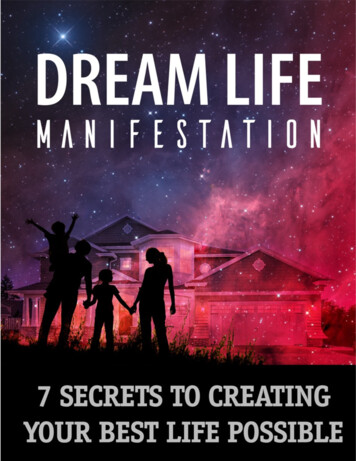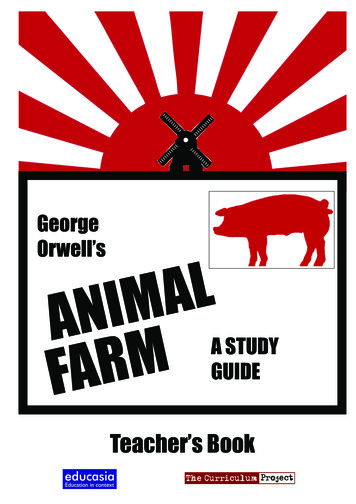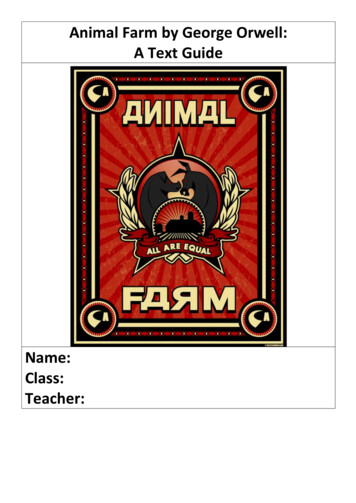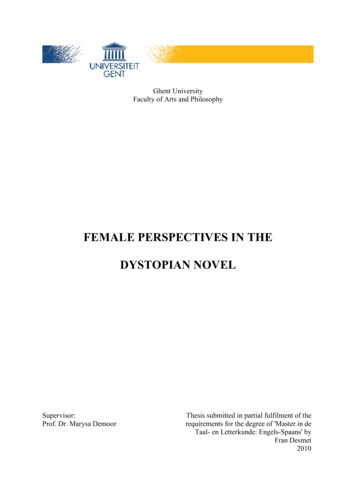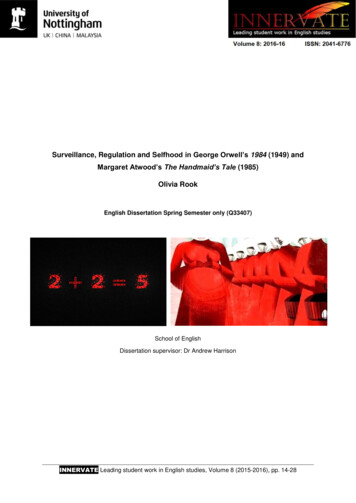
Transcription
Surveillance, Regulation and Selfhood in George Orwell’s 1984 (1949) andMargaret Atwood’s The Handmaid’s Tale (1985)Olivia RookEnglish Dissertation Spring Semester only (Q33407)School of EnglishDissertation supervisor: Dr Andrew HarrisonINNERVATE Leading student work in English studies, Volume 8 (2015-2016), pp. 14-28
Surveillance, Regulation and Selfhood in George Orwell’s 1984 (1949)and Margaret Atwood’s The Handmaid’s Tale (1985).ContentsIntroduction . .17Chapter One: 1984 . .18Chapter Two: The Handmaid’s Tale . 22Conclusion 26Bibliography . 27INNERVATE Leading student work in English studies, Volume 8 (2015-2016), pp. 14-2815
Olivia Rook16AcknowledgementsI would like to thank my supervisor, Dr Andrew Harrison, for his guidance and enthusiasm during allstages of my dissertation. Thanks also go to my family and friends for their unfailing supportthroughout my English degree. Special thanks must be extended to my father, in giving me hispassion for literature.INNERVATE Leading student work in English studies, Volume 8 (2015-2016), pp. 14-28
Surveillance, Regulation and Selfhood in George Orwell’s 1984 (1949)and Margaret Atwood’s The Handmaid’s Tale (1985).17IntroductionThe dystopian futures imagined by George Orwell in 1984 and Margaret Atwood in The Handmaid’sTale brutally challenge any notion of independence. This dissertation will seek to uncover how thesocieties they depict damage individual autonomy, and consider whether there is any form of inherent,personal resistance which can overcome this public and private oppression. I will be examining the roleof vision as a means of maintaining control, whilst also analysing the potential ways in which charactersmight retain their humanity, to determine whether there is something inalienable within the individual. Anumber of critics have been pertinent to this study. 1 Kimberley Verwaayen’s theoretically engagedarticle on forms of bodily resistance in The Handmaid’s Tale has been useful as a means of establishingOffred’s attempts at escapism, and both Peter Fifield’s and Elaine Scarry’s explorations of pain haveinformed my analysis of Winston’s torture in Room 101. However, this dissertation draws more heavilyon the work of theorists to examine ideas of surveillance, regulation and selfhood. Michel Foucault’sdiscussion of panopticism in Discipline and Punish: The Birth of the Prison (1975) provides a crucialbasis for understanding the structure of Orwell’s totalitarian world and Julia Kristeva’s theory of abjectionin Powers of Horror (1982) in relation to identity formation is interpreted to reveal how Winston andOffred manage to preserve their sense of self. The importance of these two theorists will be exploredat length.My first chapter will be on Orwell’s 1984, establishing Foucault’s framework and how it relatesto this dystopian society. My analysis will then consider the way surveillance is disseminated throughoutOceania, looking at the role of collective aggression and the power of fear in the Ministry of Love. Thegreater part of this chapter will debate the ways in which surveillance and regulation might be avoidedin order to protect identity. As a development of Kristeva’s theoretical work, the idea of reverse abjectionwill be introduced in relation to Winston’s desire to corrupt society. The body and its ability to becontrolled by the Party will also be examined. The chapter will conclude with an exploration of internaland external spaces and the extent to which the Party can exercise its regulation over them.The second chapter will explore The Handmaid’s Tale, discussing the novel’s indebtedness toOrwell’s 1984 in relation to surveillance and its effect upon the individual. Attention will be paid to formand its role in revealing Gilead’s regulation, which is evident at a narrative level throughout the novel.Through close analysis, the sexualisation of vision will be introduced before expanding into other formsof ‘looking’ and regulation. Internal and external states will be explored, with a continued emphasis onKristeva’s theories; however, the body will occupy a more central position in this chapter because ofAtwood’s attentiveness to the female condition. This dissertation will demonstrate that even in societieswhich practice total surveillance, the human is able to find a means of escape.1Orwell: Peter Fifield, Roger Paden, Elaine Scarry, Marcus Smith, James A. Tyner, Erika Gottlieb; Atwood: David Coad,Pamela Cooper, Erika Gottlieb, Clare Hanson, Amin Malak, Theodore F. Sheckels, Kimberley Verwaayen; treated together:Earl Ingersoll, Jocelyn Harris. Full details of individual publications can be found in the bibliography.INNERVATE Leading student work in English studies, Volume 8 (2015-2016), pp. 14-28
Olivia Rook18Chapter One: 1984Foucault, in writing on the Panopticon, has argued that ‘Full lighting and the eye of a supervisor capturebetter than darkness Visibility is a trap’. 2 In Discipline and Punish, he discusses how the paranoiaproduced by constant surveillance leads to self-regulation and the destruction of independence. Hisideas help to inform discussion on the theme of control in Orwell’s 1984 as the tension Foucaultdescribes between vision and the protection of shadows at a theoretical level is frighteningly realised inthis fictional dystopian future. Constantly seeking a way to preserve his humanity, the novel’s desperaterebel, Winston, finds himself negotiating the dark spaces in society’s fabric. The Party seizes control ofhis dreams and infiltrates his thoughts with the promise ‘We shall meet in the place where there is nodarkness’.3 However, the belief that O’Brien speaks to Winston ‘out of the dark’ is another of the Party’sdeceptions.4 Winston’s internal state is not concealed in protective darkness; O’Brien speaks to himfrom the penetrative glare of ‘Full lighting’. Despite the extreme levels of surveillance which see himtrapped in the Party’s ‘cruel, ingenious cage’, the novel both explores the total conditioning of theindividual and intimates that there is something inalienable about the human. 5 Even with the willingsurrender of Winston’s mind, there is hope that ‘the inner heart [will be left] inviolate’. 6Roger Paden has argued that in 1984 ‘there is little surveillance’, justifying his view byexplaining ‘There seems to be little in the way of data gathering or record keeping. There is no mentionof any universal testing, nor of physical examinations’.7 Paden’s assertion that surveillance must belinked with recorded observation, however, entirely underestimates the dangerous influence of subtleand pervasive forms of watching in Big Brother’s society. Winston is trapped in a system where ‘theperfection of power render[s] its actual exercise unnecessary the inmates [are] caught up in apower situation of which they are themselves the bearers’.8 The collective behaviour of party membersduring the Two-Minutes Hate demonstrates that they are conscious of their visibility. The scene iscuriously animalistic as party members, in a declaration of their love for Big Brother, begin screamingand aggressively moving their bodies. There is still something regimented about their instinctivebehaviour as they leap ‘up and down in their places’, refusing to break their rigid formation.9 The Partyencourages this kind of regulated mass hysteria but only within its proper, assigned place. There is alsosomething strangely dehumanising about the Two-Minutes Hate as one anonymous party member,‘The little sandy-haired woman’, stands with ‘her mouth opening and shutting like that of a landedfish’.10 Her words are not articulated; instead she operates her mouth like an automaton, the movementbeing mechanical like a programmed response. Through the insidious nature of surveillance there is abreakdown in individuation, brought about by a fear of difference.Winston’s torture takes place within the liminal location of the Ministry of Love: an unknownholding cell which exploits fear as a means of regulating behaviour. The novel repeatedly suggestsWinston’s eventual captivity because of its persistent references to being beneath ground. In hismemories he mentions the air raid shelter during the bombing of Colchester and, significantly, hisdisturbing sexual encounter with a prole woman takes place in her basement. Although his positionwithin the Ministry of Love is never confirmed, these prior images of burial and suppression foreshadownot only his physical location within the prison, but also his symbolic death. Everything about hisenvironment is artificial and tightly controlled, from the sterile ‘glittering white porcelain’ walls to the ‘waxmask’ of the guard who stands expressionless, with synthetic skin.11 Winston’s torment is complex,veering between the dull ache in his belly, his dislocation in time and place, and a fear of future pain.As Fifield explains, pain is ‘sometimes inherent and sometimes acquired, sometimes physical andsometimes psychological plac[ing] it in a tricky no-place’.12 The intense regulation of his surroundings,2The Panopticon is a type of institutional building which was created so that all inmates (the design is often attributed toprisons) can be watched by a single guard, without the inmates knowing whether and when they are being watched. Foucaulthas used the idea of the Panopticon as a metaphor for modern society and its fixation with surveillance; Michel Foucault,Discipline and Punish: The Birth of the Prison (London: Allen Lane, 1977), p. 200.3George Orwell, 1984 (London: Penguin Books, 2013), p. 29.4Ibid., p. 30.5Foucault, Discipline, p. 205.6Orwell, 1984, pp. 321-2.7Roger Paden, ‘Surveillance and Torture: Foucault and Orwell on the Methods of Discipline’, Social Theory and Practice, 10:3(1984), p. 270.8Foucault, Discipline, p. 201.9Orwell, 1984, p. 17.10Ibid., p. 17.11Ibid., pp. 259, 264.12Peter Fifield, ‘The Body, Pain, and Violence’, in The Cambridge Companion to the Body in Literature, ed. by David Hillmanand Ulrika Maude (Cambridge: Cambridge University Press, 2015), p. 117.INNERVATE Leading student work in English studies, Volume 8 (2015-2016), pp. 14-28
Surveillance, Regulation and Selfhood in George Orwell’s 1984 (1949)and Margaret Atwood’s The Handmaid’s Tale (1985).19a place where ‘you could not feel anything, except pain and the foreknowledge of pain’, therefore causesWinston a great deal of psychological anguish prior to his incarceration in Room 101.13Winston’s fear of rats has been widely debated, with Erika Gottlieb suggesting that his phobia‘is connected with that part of Winston’s own psyche that awaits behind that horrifying “wall ofdarkness” By allowing himself to be degraded to the level of the starving rats, he has become whathe most abhorred’.14 Although this affiliation between Winston and the creature he most fears producesa credible psychological reading, an alternative would be to look at the method with which O’Brienmakes Winston face his nightmare. By attaching the cage of rats to his head so that the ‘starving brutes’leap onto his face and ‘bore straight into it’, perhaps attacking ‘the eyes first’, or ‘burrow[ing] throughthe cheeks and devour[ing] the tongue’, they will destroy his distinctive features, leading to the literaleffacement of his identity.15 By threatening to attack Winston’s ability to see and articulate himself, theParty undermines any notion of independence.An inherent contradiction exists in the novel’s treatment of underground spaces. Whilst thetorture that occurs within the buried chamber of Room 101 demonstrates the total authority of the state,Winston’s concealed and seditious sexual experience with the prole woman also takes place beneathground. It is a contested space, supporting some form of surveillance but also home to the marginalwhich is supposedly free from regulation. The suggestion that there are pockets within society whichare safe from the regime is very appealing to Winston. He declares ‘If there is hope it lies in theproles’, but he also recognises the futility of trying to mobilise this ghettoised society.16 Perhaps throughwhat Marcus Smith has termed ‘the symbolic prole woman’ it is possible to imagine a world no longerunder Big Brother’s dictatorship.17 In her garden, she sings uninhibited to ‘the sweet summer air, verytuneful, charged with a sort of happy melancholy’ and establishes a crucial dichotomy between theParty and the proles: whereas Winston and Julia are desperately seeking a means to escape their staticexistence, she is content to ‘remain there for a thousand years, pegging out diapers and singingrubbish’.18 Winston recognises her as beautiful but it ‘had never before occurred to him that the bodyof a woman of fifty, blown up to monstrous dimensions by childbearing, then hardened, roughened could be beautiful’.19 She both attracts and repulses, evoking Kristeva’s theory of abjection.Kristeva’s ideas reveal the abject body to be an ambiguous and permeable vessel. It finds itselfin conflict with outside and inside, self and other as the boundaries between ‘clean’ and ‘filthy’, ‘soughtafter’ and ‘banished’, ‘fascination’ and ‘shame’ are shown to be dangerously fragile. 20 In a world where‘the clean and the proper’ stands for the Party, that which is filthy becomes desirable and the flimsydivide is breached.21 The abject represents a threat to the social order of 1984 as it provides a spacefor Winston to explore his identity. He experiences a kind of reverse abjection as his all-consumingdesire to dismantle the Party and destroy their perfect control consciously draws him to the abject. Hisexperience with the prole prostitute is fragmented as his memory pushes through the ordered narrative.The encounter is fused with recollections of his wife Katharine and her grotesque desire to fulfil their‘duty to the party’, demonstrating how Winston’s experiences with these two women are disconcertinglysimilar in their monstrous presentation of sexual relationships. 22 The narrative becomes confused asWinston’s disturbed memories flit between the women. The smell of the basement kitchen, ‘an odourcompounded of bugs and dirty clothes and villainous cheap scent, but nevertheless alluring, becauseno woman of the Party ever used scent’, shows Winston returning to the dirt as he rebels against theproscribed sexual sterility of the Party. 23 Most unsettling is the depiction of the prole woman’s mouth,no longer mechanical as if formed with hinges like the ‘The little sandy-haired woman’, but moist, sexualand all-consuming. The ‘cavernous blackness’ of the old mouth, jarringly illuminated by the grimylamplight, metaphorically indicates Winston’s journey to the fringes of society.24 This idea of reverseabjection challenges Jocelyn Harris’s belief that when Julia experiments with prole makeup ‘Winston isexcited by her “improvement” by cosmetics, her womanly longing for a frock’.25 The crude alteration ofher appearance is a show of defiance in the face of the Party’s rigorous regulation, rather than a simple13Orwell, 1984, p. 273.Erika Gottlieb, Dystopian Fiction East and West: Terror and Trial (Montreal: McGill-Queen’s University Press, 2001), p. 84.Orwell, 1984, p. 328.16Ibid., p. 80.17Marcus Smith, ‘The Wall of Blackness: A Psychological Approach to 1984’, Modern Fiction Studies, 14:4 (1968), p. 424.18Orwell, 1984, p. 163.19Ibid., p. 250.20Julia Kristeva, The Portable Kristeva, ed. by Kelly Oliver (New York: Columbia University Press, 1997), pp. 235-6.21Ibid., p. 235.22Orwell, 1984, p. 77.23Ibid., p. 74.24Ibid., p. 79.25Jocelyn Harris, ‘The Handmaid’s Tale as a ReVisioning of 1984’, in Transformations of Utopia: Changing Views of the PerfectSociety, ed. by George Slusser, Paul Alkon, Roger Gaillard, and Danièle Chatelain (New York: AMS, 1999), p. 273.1415INNERVATE Leading student work in English studies, Volume 8 (2015-2016), pp. 14-28
Olivia Rook20desire on the part of Julia to seem more ‘womanly’. And this is what truly excites Winston. It is lessabout eradicating her masculine image, forced to wear boyish trousers and keep her hair cropped;instead she wishes to banish her connection to the Party. Indeed she proclaims: “In this room I’m goingto be a woman, not a Party comrade” as though the two are diametrically opposed (italics are mine). 26Thus, in painting her face, Julia asserts her autonomy and a right to mark out her sexuality andindividuality.The body is a contested site in 1984. The Party tries to seize control of it through daily exercisesnamed The Physical Jerks but also, more worryingly, through conditioning in organisations such as theJunior Anti-Sex League, where symbolic red sashes are tied round the waists of young Party women inan archaic return to the chastity belt. They make a physical impression upon the body as, when Juliaremoves the sash, Winston notices ‘how much softer her waist seemed to feel now that the sash wasgone’.27 She becomes suppler and more human in his arms, as though the sash is simply maskingJulia’s fleshy reality. The body is the one truth the Party cannot completely avoid. Although Winston isafflicted by illness through the persistent sore on his leg, instead of weakening him it is a reminder thathe is human. Winston’s torture is a direct attack upon this secure connection to the body. Scarryexplains that ‘World, self, and voice are lost, or nearly lost, through the intense pain of torture’, andwhen Winston is brought to Room 101 he is alienated from his body. 28 The third person narrationbecomes distanced as Winston dissects and breaks down his body, describing in turn the ‘bald scalp’,‘crooked nose’ and ‘seamed’ cheeks.29 He traces his body like it is a battleground, noticing that ‘underthe dirt there were the red scars of wounds’, locating ‘near the ankle an inflamed mass’.30 O’Brientorments Winston’s body to the extent that it is no longer recognisably human and the image Winstonsees in the three-sided mirror is one produced and projected by the state. Foucault has established that‘systems of punishment are to be situated in a certain ‘political economy’ of the body it is always thebody that is at issue power relations invest it, mark it, train it, torture it’ and during Winston’s ordealin Room 101, his body is politicised, a marked emblem of Big Brother’s terrorising grip on society.31The terrifying associations attached to the corridors and rooms of the Ministry of Love areevidence for the Party’s control over physical space. Yet, even removed from these public, regulatedareas, the notion of privacy is a ludicrous fantasy. Stanley Lukasz, in discussing Henri Lefebvre’s ideason the social production of space, has asserted that ‘Marking a space introduces distinctions betweenopen and closed, clean and dirty, empty and full, seen and hidden, seeing and being seen’. 32 In thetotalitarian world of 1984, however, the oppositions of ‘open and closed’, ‘seen and hidden’ no longerexist as private spaces become public and are watched by the Party. The gaze is in-built in the veryarchitecture of Winston’s home: Victory Mansions is a dilapidated apartment complex and the securityof the domestic setting is monitored by his neighbour’s child spies. Thin, crumbling walls separate himfrom the small tyrants next door and the permeating smell of boiled-cabbage ‘common to the wholebuilding’ seeps into the rooms as a reminder that everything is shared. 33The vulnerability of Charrington’s room is indicated by the rat which tries to creep in as itforeshadows Winston’s later torture in Room 101. Earl Ingersoll has elaborated on this permeability,explaining that Winston’s ‘room and the bedroom over Charrington’s shop have never really been innersanctums but as transparent as the glass paperweight smashed by the Thought Police’. 34 Winstonhimself associates his life with this ‘little chunk of history’ as he explains ‘The paperweight was the roomhe was in, and the coral was Julia’s life and his own, fixed in a sort of eternity at the heart of the crystal’.35Coral, which allows organisms to hide and feed, supports life and is a piece of the unspoilt, naturalworld. Instead of viewing its transparent casing as protective, the coral is trapped inside a glass prison:see-through, breakable, and completely open to scrutiny. In this way, the glass paperweight is symbolicof Julia and Winston’s panoptic prison. Nevertheless, there are certain partitions and invisible limitswhich are tacitly recognised by Winston. From his physically isolated cubicle at work to the implicitdivisions within the canteen, the Party has control over movement in these seemingly open spaces.James A. Tyner has established that ‘the corporeal ‘cogs’ of the Party remained partitioned [so26Orwell, 1984, p. 164.Ibid., p. 141.28Elaine Scarry, The Body in Pain: The Making and Unmaking of the World (Oxford: Oxford University Press, 1985), p. 35.29Orwell, 1984, p. 310.30Ibid., p. 311.31Foucault, Discipline, p. 25.32Stanley Lukasz, Henri Lefebvre on Space: Architecture, Urban Research, and the Production of Theory (Minneapolis:University of Minnesota Press, 2011), p. 84.33Orwell, 1984, p. 25.34Earl Ingersoll, ‘Margaret Atwood’s “The Handmaid’s Tale”: Echoes of Orwell’, Journal of the Fantastic in the Arts, 5:4 (1993),p. 67.35Orwell, 1984, pp.168, 169.27INNERVATE Leading student work in English studies, Volume 8 (2015-2016), pp. 14-28
Surveillance, Regulation and Selfhood in George Orwell’s 1984 (1949)and Margaret Atwood’s The Handmaid’s Tale (1985).21that] no member was able to see the totality of the system’, demonstrating the disparity between BigBrother’s total sight, and the blindness imposed upon Party members.36Although the Party’s ability to observe and control physical space is unquestionable, theiraccess to the mind and internal states remains ambivalent. Their efforts to constrain the immediate,thinking mind through the limiting lexicon of Newspeak means that they are able to create a world wherepeople are unable to express their rebellion. But this does not remove the will to question Big Brother;there is a deeper and less penetrable aspect to the human psyche. The Party’s inability to completelyeradicate history has been established by Smith; he explains ‘that the past (as it operates in and throughthe unconscious) is independent of the rational control of either the Party or Winston himself’.37Winston’s desire to seek the sanctuary of dark spaces is again significant as he tries to grasp theintangible and ‘dim period of his early childhood’ through memory. 38 His mother and sister seem tobelong to this dark, other time, protected womb-like in the recesses of his mind and thus free from BigBrother’s gaze. They exist ‘down in some subterranean place – the bottom of a well, for instance, or avery deep grave looking up at him through the darkening water’.39 The unconscious process by whichhe divulges his seditious thoughts to the pages of his diary further validates Smith’s assertion as themovement is beyond Winston’s control. His incoherent stream of thought is written ‘as though byautomatic action’ and the ‘pen had slid voluptuously over the smooth paper’ as though the exchange isa sensual, bodily impulse.40 Winston’s fight in Room 101, to guard his private self, indicates thatGottlieb’s belief that totalitarianism ‘leads to the irreversible disintegration of the individual’s “innerheart”’ is too rigid a stance.41 Despite an infinite period of torture, Winston’s unconscious heart calls outto Julia on waking from a dream as, for a moment, ‘She had seemed to be not merely with him, butinside him. It was as though she had got into the texture of his skin’. 42 This inexplicable momenttemporarily takes Winston outside the Party’s control. Although he perceives it as a ‘moment ofweakness’, it is instead a hopeful demonstration of human strength in this bleak, dystopian world.43James A. Tyner, ‘Self and space, resistance and discipline: a Foucauldian reading of George Orwell’s 1984’, Social andCultural Geography, 5:1 (2004), p. 136.37Smith, ‘Blackness’, p. 424.38Orwell, 1984, p. 37.39Ibid., p. 34.40Ibid., p. 21.41Gottlieb, Trial, p. 85.42Orwell, 1984, p. 321.43Ibid., p. 321.36INNERVATE Leading student work in English studies, Volume 8 (2015-2016), pp. 14-28
Olivia Rook22Chapter Two: The Handmaid’s TaleMargaret Atwood has revealed that ‘Orwell became a direct model for me in the real 1984, the yearin which I began writing a somewhat different dystopia’. 44 The Handmaid’s Tale uses the framework of1984 as a basis for Atwood’s own horrifying dystopian future. The two have been treated together bycritics such as Earl Ingersoll and Jocelyn Harris, yet the focus has always remained on Winston andOffred’s roles as writers and on obvious thematic comparisons between the novels. This dissertation isunusual in questioning whether the human has an intrinsic ability to rise above an external, oppressivesystem. Arguably both novels are hesitant in providing definite answers; however, a sense ofambivalence is stronger in 1984 as Atwood explicitly draws upon the body and her female narrative asa means of escaping regulation. As Harris explains, ‘The Handmaid’s Tale is a re-vision through thelens of gender’, something which has been elaborated on by feminist critic Kimberley Verwaayen. 45Drawing upon the French feminist theorists Luce Irigaray and Hélène Cixous, she has looked at Offred’sreclamation of the body as a means of expression beyond the text. Although she makes brief referenceto Kristeva in her introduction, this dissertation will place greater emphasis on her theories of abjectionand the semiotic in relation to Offred’s challenge to Gilead’s patriarchal rule.Ingersoll has optimistically interpreted Atwood’s Historical Notes section, believing that it‘certainly offers a somewhat brighter future when Gilead and patriarchal repression for a time havecome to an end’.46 Although they indicate a time beyond Gilead, where women are allowed to be presentat an academic symposium and Offred’s account is indeed a piece of the past, this is by no meansproof that aspects of this misogynistic society have been eradicated. Instead of indicating a ‘brighterfuture’, they are confirmation of Offred’s erasure from her own narrative. The form of the noveldemonstrates how Offred is continuing to be policed. Professor Pieixoto, a male academic from theworld’s most prestigious and leading institution, and thus a source of traditional power in this futuresociety, openly mocks the women of Gilead. He recounts how they escaped using “The UndergroundFrailroad” and ridicules women’s position as sexual objects: he explains that ‘all puns were intentional’in naming the document “The Handmaid’s Tale”, ‘that being, to some extent, the bone, as it were, ofcontention’.47 Whilst the majority of the novel focuses on Offred’s body as an object for examination, inthe Historical Notes it is her voice which is dissected and debated, the recordings transcribed ‘basedon some guesswork’.48 Pamela Cooper has argued that ‘As a voice, [Offred] seems absolutely liberatedfrom her flesh, escaped at once from her body and from Gilead’. 49 However, the control is simplyredirected. Instead of attacking her external body, this conference challenges her internal voice whichis arguably more damaging.Aunt Lydia’s assertion that ‘To be seen – to be seen – is to be penetrated’ encapsulatesGilead’s method of patriarchal regulation.50 Surveillance becomes sexualised as the ‘institutional gaze’is inherently male, carried out by a group of men aptly named ‘the Eyes’. 51 With the restriction of touch,vision becomes invasive and intimate. When Offred moves away from a checkpoint, she knows theGuardians are watching, ‘these two men who aren’t yet permitted to touch women. They touch withtheir eyes instead and [she] move[s] [her] hips a little’ in response.52 This sexual exchange, althoughcasting the male as observer, complicates the power asymmetry, with Theodore F. Sheckels evensuggesting that Offred ‘is a victim turning into a victimiser’: she uses their gaze to empower herself. 53Indeed, she even reflects the gaze, causing the Guardian to be the first ‘one who turns away’ when theylock eyes between her wings.54 Her simile reveals the vulnerability of the young soldier, his ‘exposedface’, ‘like the skin under a scab’, demonstrating how Offred’s look gets beneath the fragile skin,physically penetrating this protective exterior. 55 The Commander, too, betrays his isolation throughwatching when Offred rubs lotion into her body, as he wears an expression as if ‘looking in through theMargaret Atwood, ‘My hero: George Orwell by Margaret Atwood’, The Guardian (January 2013) ro-george-orwell-atwood [accessed 2 April 2016].45Harris, ‘ReVisioning’, p. 276.46Ingersoll, ‘Echoes’, p. 72.47Margaret Atwood, The Handmaid’s Tale (London: Vintage Books, 2010), p. 313.48Ibid., p. 314.49Pamela Cooper, ‘“A body story with a vengeance”: Anatomy and struggle in The Bell Jar and The Handmaid’s Tale’,Women’s Studies, 26:1 (1997), p. 99.50Atwood, THT, p. 39.51Kimberley Verwaayen, ‘Re-examining the gaze in The Handmaid’s Tale’, Open Letter: A Canadian Journal of Writing andTheory, 9:4 (1995), p. 44.52Atwood, THT, p. 32.53Theodore F. Sheckels, The Political in Margaret Atwood’s Fiction: The Writing on the Wall of the Tent (London: Routledge,2016), p. 91.54Atwood, THT, p. 31.55Ibid., p. 31.44INNERVATE Leading student work in English studies, Volume 8 (2015-2016), pp. 14-28
Surveillance, Regulation and Selfhood in George Orwell’s 1984 (1949)and Margaret Atwood’s The Handmaid’s Tale (1985).23bars’.56 Both men, in these instances, are disempowered, locked within their bodies and unable toaccess the female beyond the detachment of a voyeur.Women looking on themselves and
Surveillance, Regulation and Selfhood in George Orwell's 1984 (1949) and Margaret Atwood's The Handmaid's Tale (1985). 17 INNERVATE Leading student work in English studies, Volume 8 (2015-2016), pp. 14-28 Introduction The dystopian futures imagined by George Orwell in 1984 and Margaret Atwood in The Handmaid's Tale brutally challenge any notion of independence.
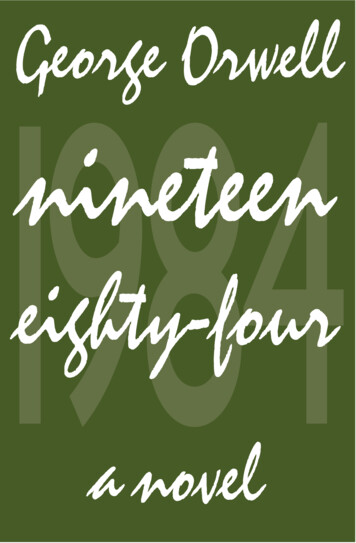
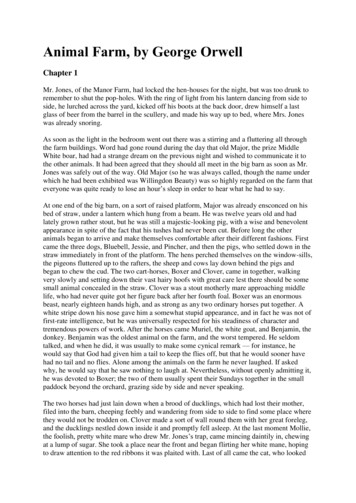

![Orwell, George - Nineteen eighty-four -biling e [pdf]](/img/26/1984-bilingue.jpg)
